Modelling Soil Compaction Parameters Using an Enhanced Hybrid Intelligence Paradigm of ANFIS and Improved Grey Wolf Optimiser
Abstract
1. Introduction
2. Research Significance
3. Methodology
3.1. Adaptive Neuro-Fuzzy Inference System
- Rule-1:
- Rule-2:
- Layer 1: Fuzzification layer—it is assumed that node has an adaptive function as: , where is the output of node i, while denotes the MF.
- Layer 2: Ruler layer—Node within this layer is assumed to be fixed (II). In addition, the node output is generated by incoming signals, such as , where denotes the output of the second layer, and represents the firing strength of rule .
- Layer 3: Normalisation layer—Node i undergoes normalisation in the third layer (firing strengths). The ratio of the firing force of rule i to the total firing force can be obtained as: , where is the output of the third layer, and stands for the normalised firing strength.
- Layer 4: Defuzzification layer—In this layer, each of the nodes is adaptive and has a function representing the contribution of rule i to the total output.
- Layer 5: Output layer—Eventually, this layer yields the final output.
3.2. Grey Wolf Optimiser
3.3. Improved Grey Wolf Optimiser
3.4. Brief Overview of MFO, SMA, and MPA
3.5. Hybrid Modelling of ANFIS and MHAs
4. Data Description and Modelling
5. Results and Discussion
5.1. Model Performance
5.2. Discussion of Results
6. Limitations and Future Research
7. Summary and Conclusions
Supplementary Materials
Author Contributions
Funding
Data Availability Statement
Conflicts of Interest
Nomenclature
| ANFIS | Adaptive neuro-fuzzy inference system | MF | Membership function |
| ANFIS-GWO | Hybrid model of ANFIS and GWO | MFO | Moth-flame optimisation |
| ANFIS-IGWO | Hybrid model of ANFIS and IGWO | MHA | Meta-heuristic algorithm |
| ANFIS-MFO | Hybrid model of ANFIS and MFO | MLT | Machine learning technique |
| ANFIS-MPA | Hybrid model of ANFIS and MPA | MPA | Marine predators algorithm |
| ANFIS-SMA | Hybrid model of ANFIS and SMA | NFIS | Number of FIS parameters |
| ANN | Artificial neural network | OMC | Optimum moisture content |
| C&A | Consequent and antecedent | PFI | Performance index |
| E&E | Exploration and exploitation | PL | Plastic limit |
| ELM | Extreme learning machine | R | Correlation coefficient |
| EPR | Evolutionary polynomial regression | R2 | Determination coefficient |
| F | Fines content | RMSE | Root mean square error |
| FIS | Fuzzy inference system | RSR | RMSE to observation’s standard deviation ratio |
| G | Gravel content | S | Sand content |
| GMDH | Group method of data handling | SMA | Slime mould algorithm |
| GWO | Grey wolf optimiser | SVM | Support vector machine |
| IGWO | Improved grey wolf optimiser | TR | Training subset |
| LL | Liquid limit | TS | Testing subset |
| LSSVM | Least square support vector machine | VAF | Variance account factor |
| MAE | Mean absolute error | WI | Willmott’s Index of agreement |
| MDD | Maximum dry density | WMAPE | Weighted mean absolute percentage error |
Appendix A
- MATLAB implementation for the developed ANFIS-IGWO model.
- %% Dataset uploading: For dataset uploading via an Excel sheet named ‘PROJECT.’ The training dataset should be kept in the TR sheet, and the testing dataset should be kept in the TS sheet. The output value should be placed in the right-most column. All the values are given in normalised form.
- train=xlsread(′PROJECT′, ′TR′);
- test=xlsread(′PROJECT′, ′TS′);
- xtrain = train(:,1:end-1); ytrain = train(:,end);
- xtest = test(:,1:end-1); ytest = test(:,end);
- %% Loading of the ANFIS-IGWO model for OMC estimation
- %% Loading of anfis_igwo_mdd is necessary for MDD estimation
- load anfis_igwo_omc
- load anfis_igwo_mdd
- %% Prediction of training and testing outputs (normalised values)
- Pr_train_norm=evalfis(xtrain,fis);
- Pr_test_norm=evalfis(xtest,fis);
- %% Generation of de-normalisation values of OMC
- Pr_train_act=(Pr_train_norm*24) + 7;
- Pr_test_act=(Pr_test_norm*24) + 7;
- %% Generation of de-normalisation values of MDD
- Pr_train_act=(Pr_train_norm*7.7499) + 13.7340;
- Pr_test_act=(Pr_test_norm*7.7499) + 13.7340;
References
- Wang, H.-L.; Yin, Z.-Y. High performance prediction of soil compaction parameters using multi expression programming. Eng. Geol. 2020, 276, 105758. [Google Scholar] [CrossRef]
- Tatsuoka, F.; Correia, A.G. Importance of controlling the degree of saturation in soil compaction linked to soil structure design. Transp. Geotech. 2018, 17, 3–23. [Google Scholar] [CrossRef]
- Proctor, R. Fundamental principles of soil compaction. Eng. News Record. 1933, 111. [Google Scholar]
- Xu, C.; Chen, Z.; Li, J.; Xiao, Y. Compaction of subgrade by high-energy impact rollers on an airport runway. J. Perform. Constr. Facil. 2014, 28, 4014021. [Google Scholar] [CrossRef]
- Chen, R.-P.; Qi, S.; Wang, H.-L.; Cui, Y.-J. Microstructure and hydraulic properties of coarse-grained subgrade soil used in high-speed railway at various compaction degrees. J. Mater. Civ. Eng. 2019, 31, 4019301. [Google Scholar] [CrossRef]
- Xu, Z.; Li, X.; Li, J.; Xue, Y.; Jiang, S.; Liu, L.; Luo, Q.; Wu, K.; Zhang, N.; Feng, Y. Characteristics of source rocks and genetic origins of natural gas in deep formations, Gudian Depression, Songliao Basin, NE China. ACS Earth Space Chem. 2022, 6, 1750–1771. [Google Scholar] [CrossRef]
- Wu, Z.; Xu, J.; Li, Y.; Wang, S. Disturbed state concept–based model for the uniaxial strain-softening behavior of fiber-reinforced soil. Int. J. Geomech. 2022, 22, 4022092. [Google Scholar] [CrossRef]
- Ren, C.; Yu, J.; Liu, S.; Yao, W.; Zhu, Y.; Liu, X. A plastic strain-induced damage model of porous rock suitable for different stress paths. Rock Mech. Rock Eng. 2022, 55, 1887–1906. [Google Scholar] [CrossRef]
- Najjar, Y.M.; Basheer, I.A.; Naouss, W.A. On the identification of compaction characteristics by neuronets. Comput. Geotech. 1996, 18, 167–187. [Google Scholar] [CrossRef]
- Nagaraj, H.B.; Reesha, B.; Sravan, M.V.; Suresh, M.R. Correlation of compaction characteristics of natural soils with modified plastic limit. Transp. Geotech. 2015, 2, 65–77. [Google Scholar] [CrossRef]
- Peng, J.; Xu, C.; Dai, B.; Sun, L.; Feng, J.; Huang, Q. Numerical investigation of brittleness effect on strength and microcracking behavior of crystalline rock. Int. J. Geomech. 2022, 22, 4022178. [Google Scholar] [CrossRef]
- Fu, Q.; Gu, M.; Yuan, J.; Lin, Y. Experimental study on vibration velocity of piled raft supported embankment and foundation for ballastless high speed railway. Buildings 2022, 12, 1982. [Google Scholar] [CrossRef]
- Cheng, F.; Li, J.; Zhou, L.; Lin, G. Fragility analysis of nuclear power plant structure under real and spectrum-compatible seismic waves considering soil-structure interaction effect. Eng. Struct. 2023, 280, 115684. [Google Scholar] [CrossRef]
- Bardhan, A.; Asteris, P.G. Application of hybrid ANN paradigms built with nature inspired meta-heuristics for modelling soil compaction parameters. Transp. Geotech. 2023, 41, 100995. [Google Scholar] [CrossRef]
- Günaydın, O. Estimation of soil compaction parameters by using statistical analyses and artificial neural networks. Environ. Geol. 2009, 57, 203–215. [Google Scholar] [CrossRef]
- Kurnaz, T.F.; Kaya, Y. The performance comparison of the soft computing methods on the prediction of soil compaction parameters. Arab. J. Geosci. 2020, 13, 159. [Google Scholar] [CrossRef]
- Tiwari, L.B.; Burman, A.; Samui, P. Modelling soil compaction parameters using a hybrid soft computing technique of LSSVM and symbiotic organisms search. Innov. Infrastruct. Solut. 2023, 8, 2. [Google Scholar] [CrossRef]
- Sinha, S.K.; Wang, M.C. Artificial neural network prediction models for soil compaction and permeability. Geotech. Geol. Eng. 2008, 26, 47–64. [Google Scholar] [CrossRef]
- Ardakani, A.; Kordnaeij, A. Soil compaction parameters prediction using GMDH-type neural network and genetic algorithm. Eur. J. Environ. Civ. Eng. 2019, 23, 449–462. [Google Scholar] [CrossRef]
- Yu, J.; Zhu, Y.; Yao, W.; Liu, X.; Ren, C.; Cai, Y.; Tang, X. Stress relaxation behaviour of marble under cyclic weak disturbance and confining pressures. Measurement 2021, 182, 109777. [Google Scholar] [CrossRef]
- Wang, W.; Li, D.-Q.; Tang, X.-S.; Du, W. Seismic fragility and demand hazard analyses for earth slopes incorporating soil property variability. Soil Dyn. Earthq. Eng. 2023, 173, 108088. [Google Scholar] [CrossRef]
- Ran, C.; Bai, X.; Tan, Q.; Luo, G.; Cao, Y.; Wu, L.; Chen, F.; Li, C.; Luo, X.; Liu, M. Threat of soil formation rate to health of karst ecosystem. Sci. Total Environ. 2023, 887, 163911. [Google Scholar] [CrossRef] [PubMed]
- Liu, Y.; Li, J.; Lin, G. Seismic performance of advanced three-dimensional base-isolated nuclear structures in complex-layered sites. Eng. Struct. 2023, 289, 116247. [Google Scholar] [CrossRef]
- Bui, D.T.; Nhu, V.-H.; Hoang, N.-D. Prediction of soil compression coefficient for urban housing project using novel integration machine learning approach of swarm intelligence and multi-layer perceptron neural network. Adv. Eng. Inform. 2018, 38, 593–604. [Google Scholar]
- Truong, V.-H.; Pham, H.-A.; Van, T.H.; Tangaramvong, S. Evaluation of machine learning models for load-carrying capacity assessment of semi-rigid steel structures. Eng. Struct. 2022, 273, 115001. [Google Scholar] [CrossRef]
- Truong, V.-H.; Papazafeiropoulos, G.; Vu, Q.-V.; Pham, V.-T.; Kong, Z. Predicting the patch load resistance of stiffened plate girders using machine learning algorithms. Ocean Eng. 2021, 240, 109886. [Google Scholar] [CrossRef]
- Benbouras, M.A.; Lefilef, L. Progressive machine learning approaches for predicting the soil compaction parameters. Transp. Infrastruct. Geotechnol. 2023, 10, 211–238. [Google Scholar] [CrossRef]
- Golafshani, E.M.; Behnood, A.; Arashpour, M. Predicting the compressive strength of normal and High-Performance Concretes using ANN and ANFIS hybridized with Grey Wolf Optimizer. Constr. Build. Mater. 2020, 232, 117266. [Google Scholar] [CrossRef]
- Le, L.T.; Nguyen, H.; Dou, J.; Zhou, J. A comparative study of PSO-ANN, GA-ANN, ICA-ANN, and ABC-ANN in estimating the heating load of buildings’ energy efficiency for smart city planning. Appl. Sci. 2019, 9, 2630. [Google Scholar] [CrossRef]
- Piro, N.S.; Mohammed, A.; Hamad, S.M.; Kurda, R. Artificial neural networks (ANN), MARS, and adaptive network-based fuzzy inference system (ANFIS) to predict the stress at the failure of concrete with waste steel slag coarse aggregate replacement. Neural Comput. Appl. 2023, 35, 13293–13319. [Google Scholar] [CrossRef]
- Ojha, V.K.; Abraham, A.; Snášel, V. Metaheuristic design of feedforward neural networks: A review of two decades of research. Eng. Appl. Artif. Intell. 2017, 60, 97–116. [Google Scholar] [CrossRef]
- Behnood, A.; Golafshani, E.M. Predicting the compressive strength of silica fume concrete using hybrid artificial neural network with multi-objective grey wolves. J. Clean. Prod. 2018, 202, 54–64. [Google Scholar] [CrossRef]
- Ly, H.-B.; Pham, B.T.; Le, L.M.; Le, T.-T.; Le, V.M.; Asteris, P.G. Estimation of axial load-carrying capacity of concrete-filled steel tubes using surrogate models. Neural Comput. Appl. 2021, 33, 3437–3458. [Google Scholar] [CrossRef]
- Smys, S.; Balas, V.E.; Kamel, K.A.; Lafata, P. Inventive Computation and Information Technologies; Springer: Berlin/Heidelberg, Germany, 2021. [Google Scholar]
- Samantaray, S.; Sumaan, P.; Surin, P.; Mohanta, N.R.; Sahoo, A. Prophecy of groundwater level using hybrid ANFIS-BBO approach. In Proceedings of International Conference on Data Science and Applications: ICDSA 2021; Springer: Berlin/Heidelberg, Germany, 2022; Volume 1, pp. 273–283. [Google Scholar]
- Joshi, H.; Arora, S. Enhanced grey wolf optimization algorithm for global optimization. Fundam. Informaticae 2017, 153, 235–264. [Google Scholar] [CrossRef]
- Qais, M.H.; Hasanien, H.M.; Alghuwainem, S. Augmented grey wolf optimizer for grid-connected PMSG-based wind energy conversion systems. Appl. Soft Comput. 2018, 69, 504–515. [Google Scholar] [CrossRef]
- Gupta, S.; Deep, K.; Mirjalili, S. An efficient equilibrium optimizer with mutation strategy for numerical optimization. Appl. Soft Comput. 2020, 96, 106542. [Google Scholar] [CrossRef]
- Ding, Q.; Xu, X. Improved GWO Algorithm for UAV Path Planning on Crop Pest Monitoring. Issue Special Issue on Multimedia Streaming and Processing in Internet of Things with Edge Intelligence. Int. J. Interact. Multimed. Artif. Intell. 2022, 7, 30–39. [Google Scholar] [CrossRef]
- Rosenblatt, F. The perceptron: A probabilistic model for information storage and organization in the brain. Psychol. Rev. 1958, 65, 386. [Google Scholar] [CrossRef]
- Chen, H.; Asteris, P.G.; Armaghani, D.J.; Gordan, B.; Pham, B.T. Assessing dynamic conditions of the retaining wall: Developing two hybrid intelligent models. Appl. Sci. 2019, 9, 1042. [Google Scholar] [CrossRef]
- Armaghani, D.J.; Ming, Y.Y.; Mohammed, A.S.; Momeni, E.; Maizir, H. Effect of Different Kernels of the Support Vector Machine to Forecast the Bearing Capacity of Deep Foundation. J. Soft Comput. Civ. Eng. 2023, 7, 111–128. [Google Scholar]
- Ahmed, H.U.; Mohammed, A.S.; Faraj, R.H.; Abdalla, A.A.; Qaidi, S.M.A.; Sor, N.H.; Mohammed, A.A. Innovative modeling techniques including MEP, ANN and FQ to forecast the compressive strength of geopolymer concrete modified with nanoparticles. Neural Comput. Appl. 2023, 35, 12453–12479. [Google Scholar] [CrossRef]
- Asteris, P.G.; Tsaris, A.K.; Cavaleri, L.; Repapis, C.C.; Papalou, A.; Di Trapani, F.; Karypidis, D.F. Prediction of the fundamental period of infilled RC frame structures using artificial neural networks. Comput. Intell. Neurosci. 2016, 2016, 20. [Google Scholar] [CrossRef] [PubMed]
- He, B.; Armaghani, D.J.; Lai, S.H. Assessment of tunnel blasting-induced overbreak: A novel metaheuristic-based random forest approach. Tunn. Undergr. Space Technol. 2023, 133, 104979. [Google Scholar] [CrossRef]
- Indraratna, B.; Armaghani, D.J.; Correia, A.G.; Hunt, H.; Ngo, T. Prediction of resilient modulus of ballast under cyclic loading using machine learning techniques. Transp. Geotech. 2023, 38, 100895. [Google Scholar] [CrossRef]
- Shan, F.; He, X.; Armaghani, D.J.; Zhang, P.; Sheng, D. Success and challenges in predicting TBM penetration rate using recurrent neural networks. Tunn. Undergr. Space Technol. 2022, 130, 104728. [Google Scholar] [CrossRef]
- Li, D.; Liu, Z.; Xiao, P.; Zhou, J.; Armaghani, D.J. Intelligent rockburst prediction model with sample category balance using feedforward neural network and Bayesian optimization. Undergr. Space 2022, 7, 833–846. [Google Scholar] [CrossRef]
- Paryani, S.; Neshat, A.; Javadi, S.; Pradhan, B. Comparative performance of new hybrid ANFIS models in landslide susceptibility mapping. Nat. Hazards. 2020, 103, 1961–1988. [Google Scholar] [CrossRef]
- Mustafa, R.; Samui, P.; Kumari, S. Reliability Analysis of Gravity Retaining Wall Using Hybrid ANFIS. Infrastructures 2022, 7, 121. [Google Scholar] [CrossRef]
- Jang, J.-S. ANFIS: Adaptive-network-based fuzzy inference system. IEEE Trans. Syst. Man. Cybern. 1993, 23, 665–685. [Google Scholar] [CrossRef]
- Mirjalili, S.; Mirjalili, S.M.; Lewis, A. Grey Wolf Optimizer. Adv. Eng. Softw. 2014, 69, 46–61. [Google Scholar] [CrossRef]
- Nadimi-Shahraki, M.H.; Taghian, S.; Mirjalili, S. An improved grey wolf optimizer for solving engineering problems. Expert Syst. Appl. 2021, 166, 113917. [Google Scholar] [CrossRef]
- Tumar, I.; Hassouneh, Y.; Turabieh, H.; Thaher, T. Enhanced binary moth flame optimization as a feature selection algorithm to predict software fault prediction. IEEE Access 2020, 8, 8041–8055. [Google Scholar] [CrossRef]
- Tiachacht, S.; Khatir, S.; Le Thanh, C.; Rao, R.V.; Mirjalili, S.; Wahab, M.A. Inverse problem for dynamic structural health monitoring based on slime mould algorithm. Eng. Comput. 2021, 38, 2205–2228. [Google Scholar] [CrossRef]
- AlRassas, A.M.; Al-Qaness, M.A.A.; Ewees, A.A.; Ren, S.; Sun, R.; Pan, L.; Elaziz, M.A. Advance artificial time series forecasting model for oil production using neuro fuzzy-based slime mould algorithm. J. Pet. Explor. Prod. Technol. 2022, 12, 383–395. [Google Scholar] [CrossRef]
- Al-Qaness, M.A.A.; Ewees, A.A.; Fan, H.; Abualigah, L.; Elaziz, M.A. Marine predators algorithm for forecasting confirmed cases of COVID-19 in Italy, USA. Iran and Korea. Int. J. Environ. Res. Public Health 2020, 17, 3520. [Google Scholar] [CrossRef]
- Mirjalili, S. Moth-flame optimization algorithm: A novel nature-inspired heuristic paradigm. Knowl. Based Syst. 2015, 89, 228–249. [Google Scholar] [CrossRef]
- Li, S.; Chen, H.; Wang, M.; Heidari, A.A.; Mirjalili, S. Slime mould algorithm: A new method for stochastic optimization. Futur. Gener. Comput. Syst. 2020, 111, 300–323. [Google Scholar] [CrossRef]
- Faramarzi, A.; Heidarinejad, M.; Mirjalili, S.; Gandomi, A.H. Marine Predators Algorithm: A nature-inspired metaheuristic. Expert Syst. Appl. 2020, 152, 113377. [Google Scholar] [CrossRef]
- ASTM Committee D-18 on Soil and Rock. Standard Practice for Classification of Soils for Engineering Purposes (Unified Soil Classification System); ASTM International: West Conshohocken, PA, USA, 2017. [Google Scholar]
- Taylor, K.E. Summarizing multiple aspects of model performance in a single diagram. J. Geophys. Res. Atmos. 2001, 106, 7183–7192. [Google Scholar] [CrossRef]

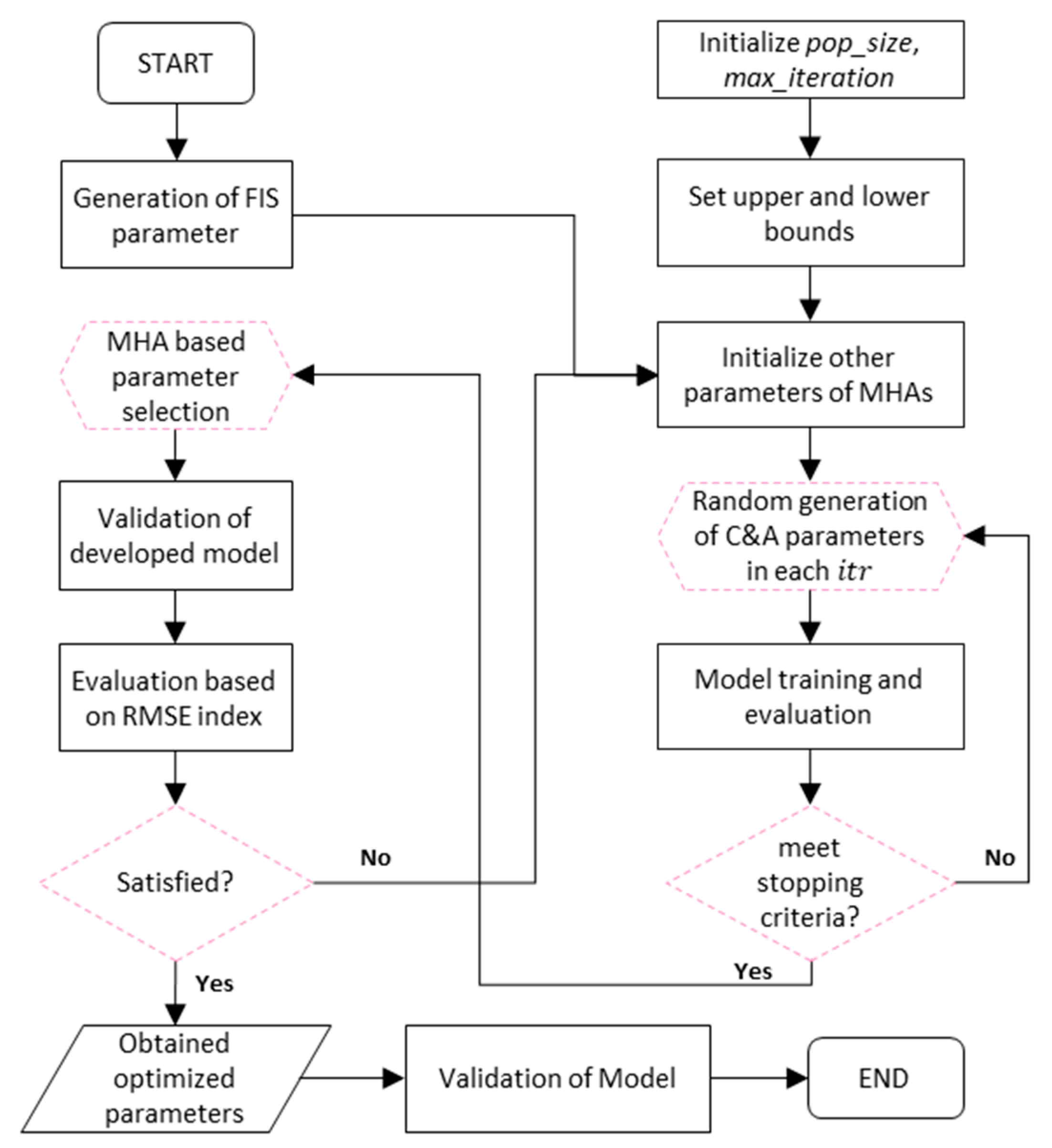
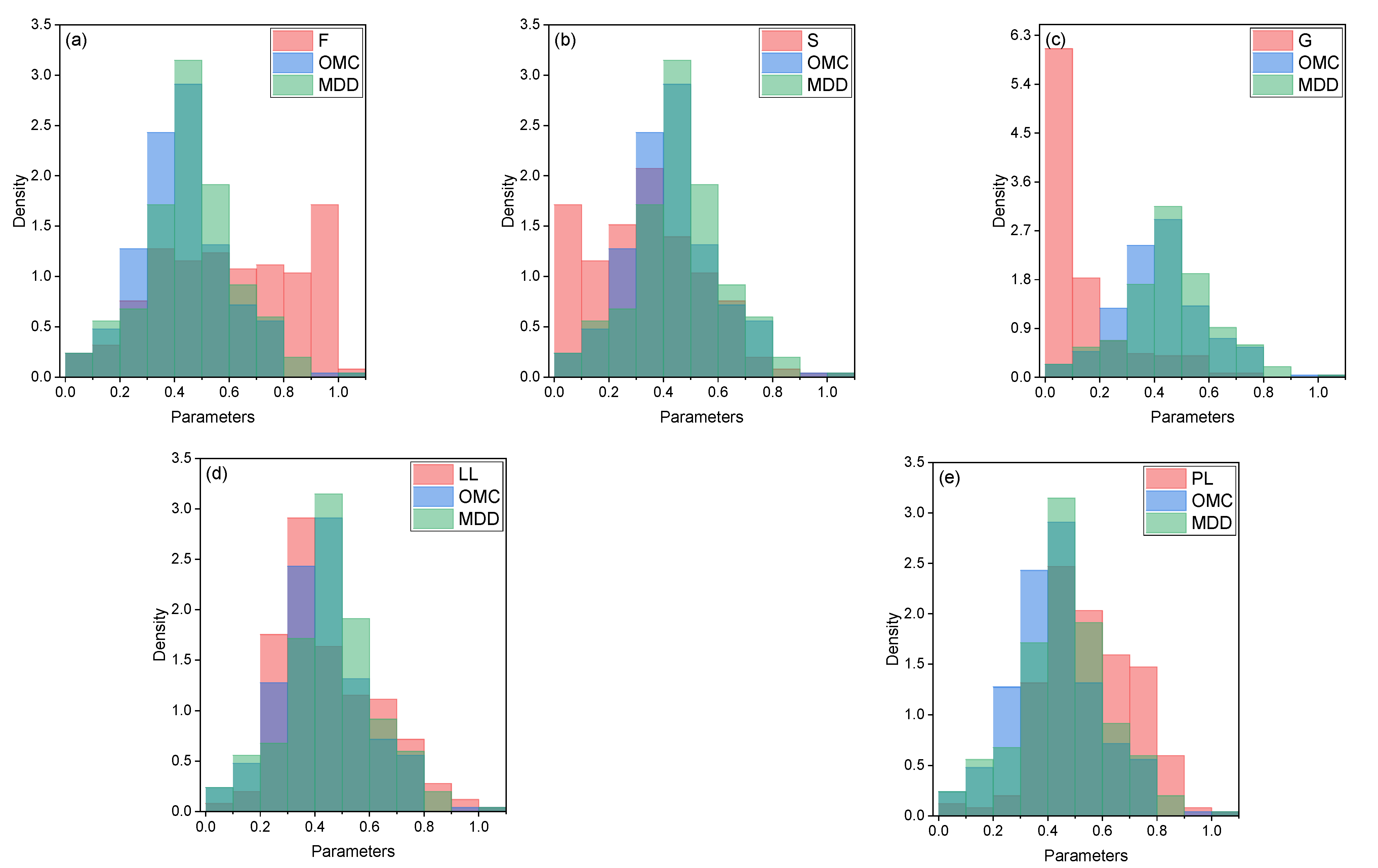

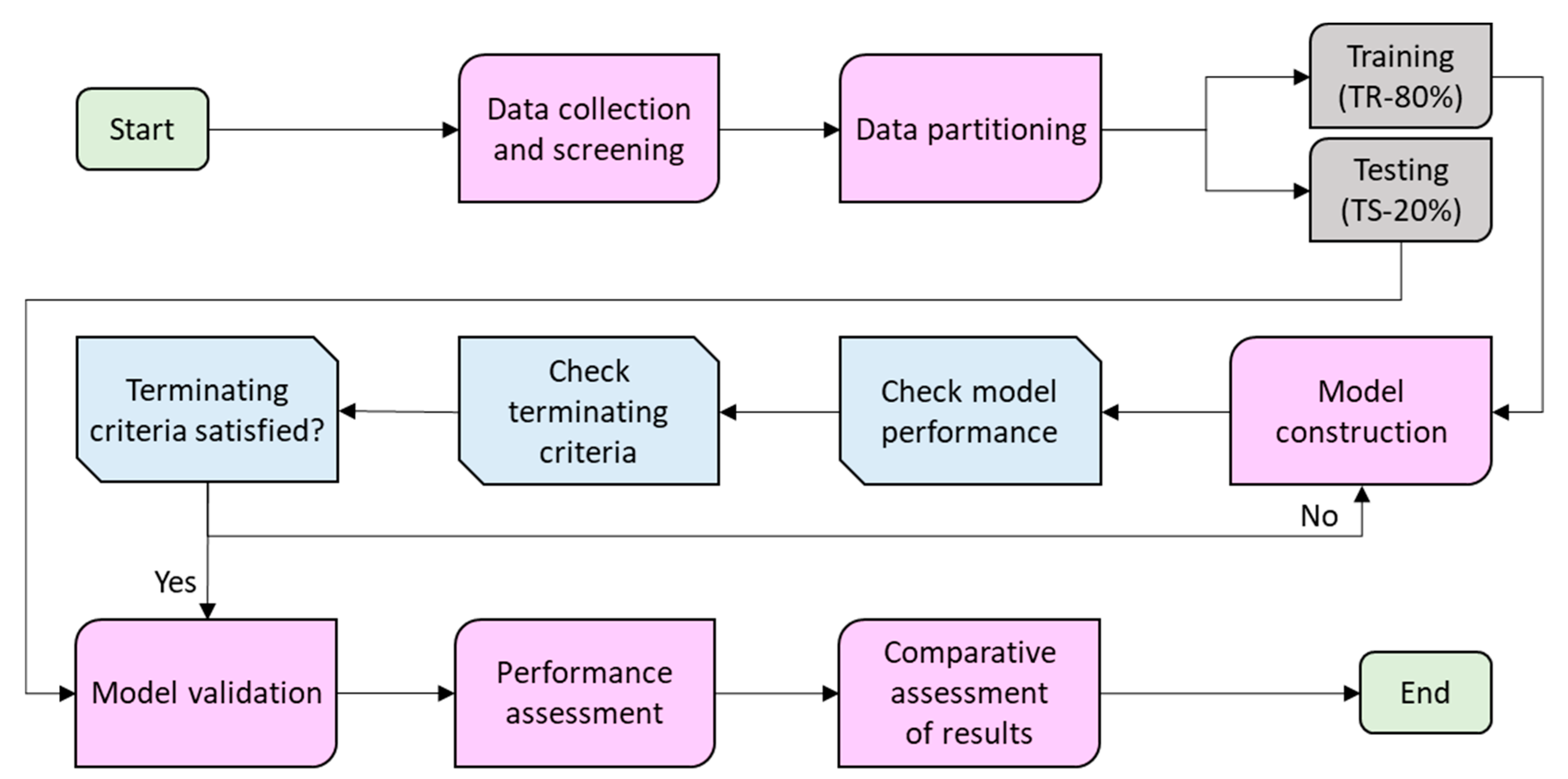
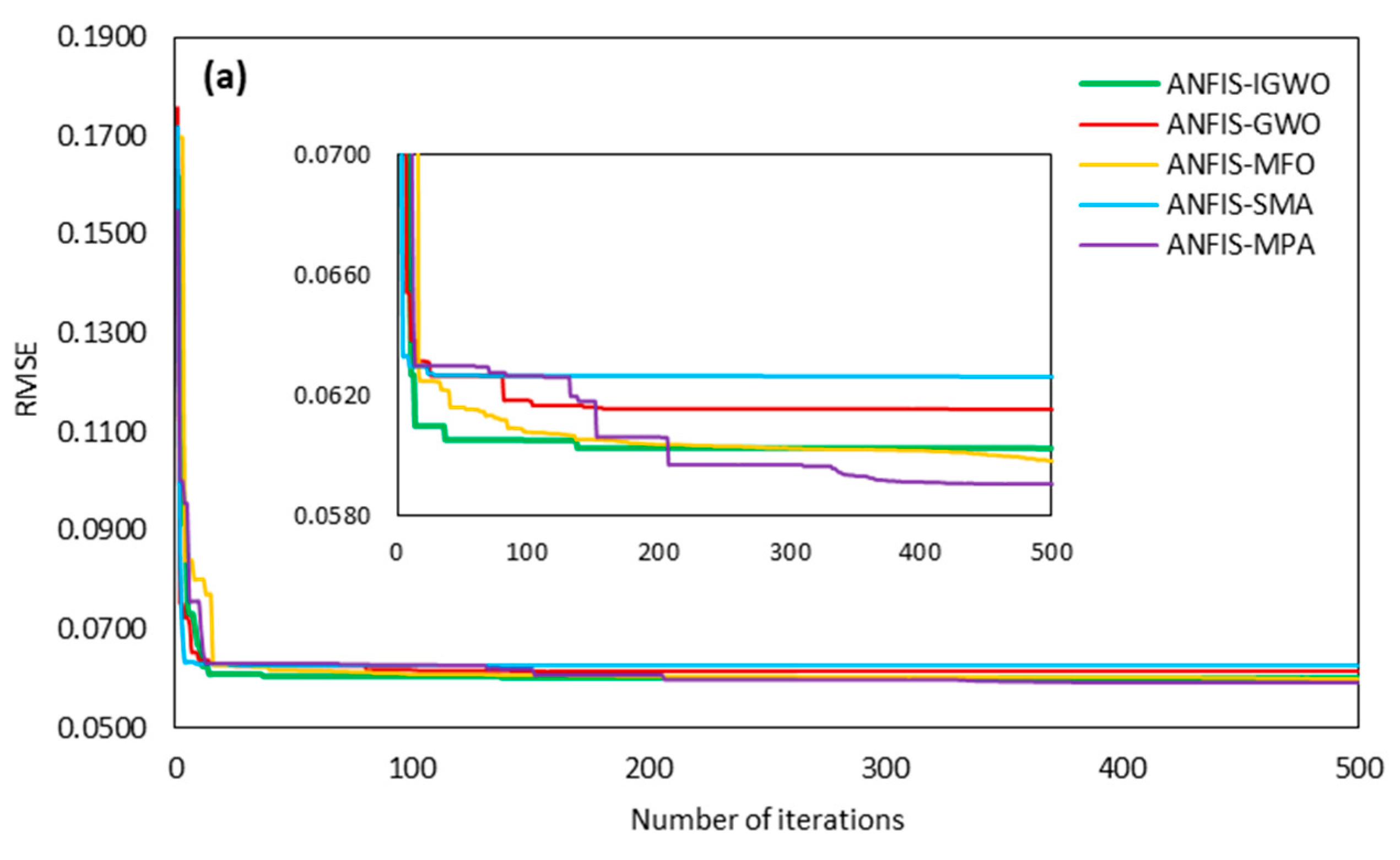
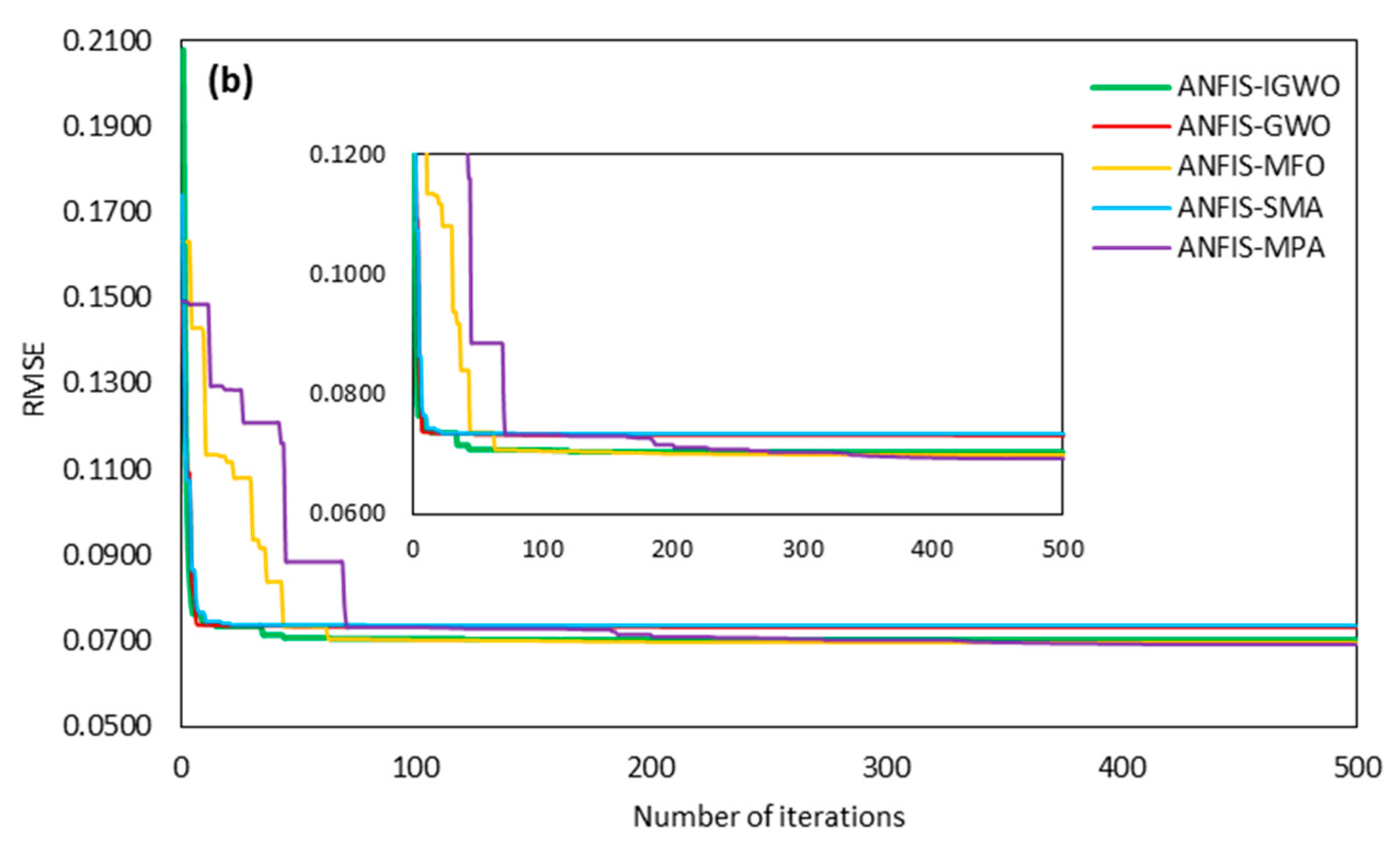

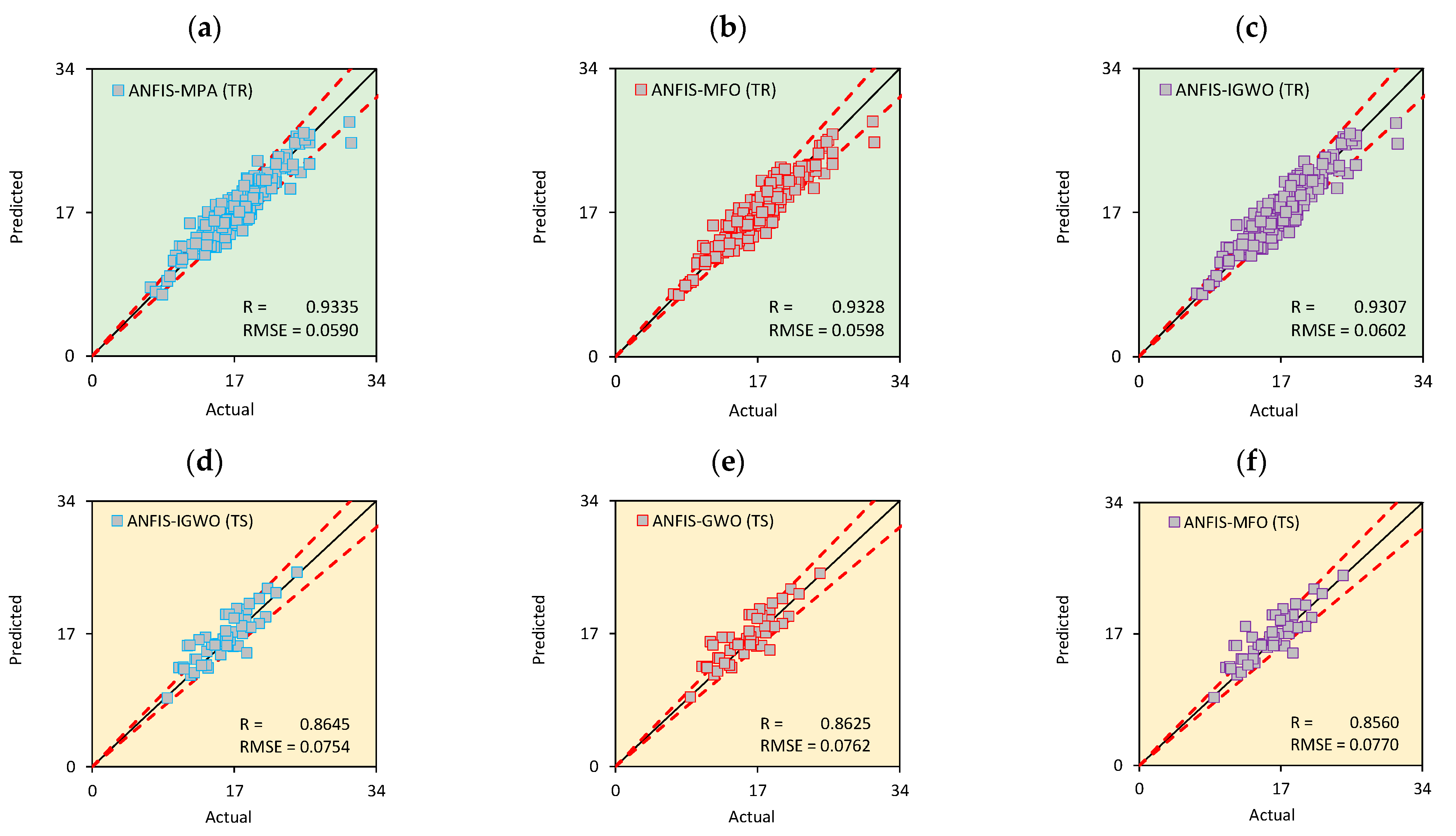

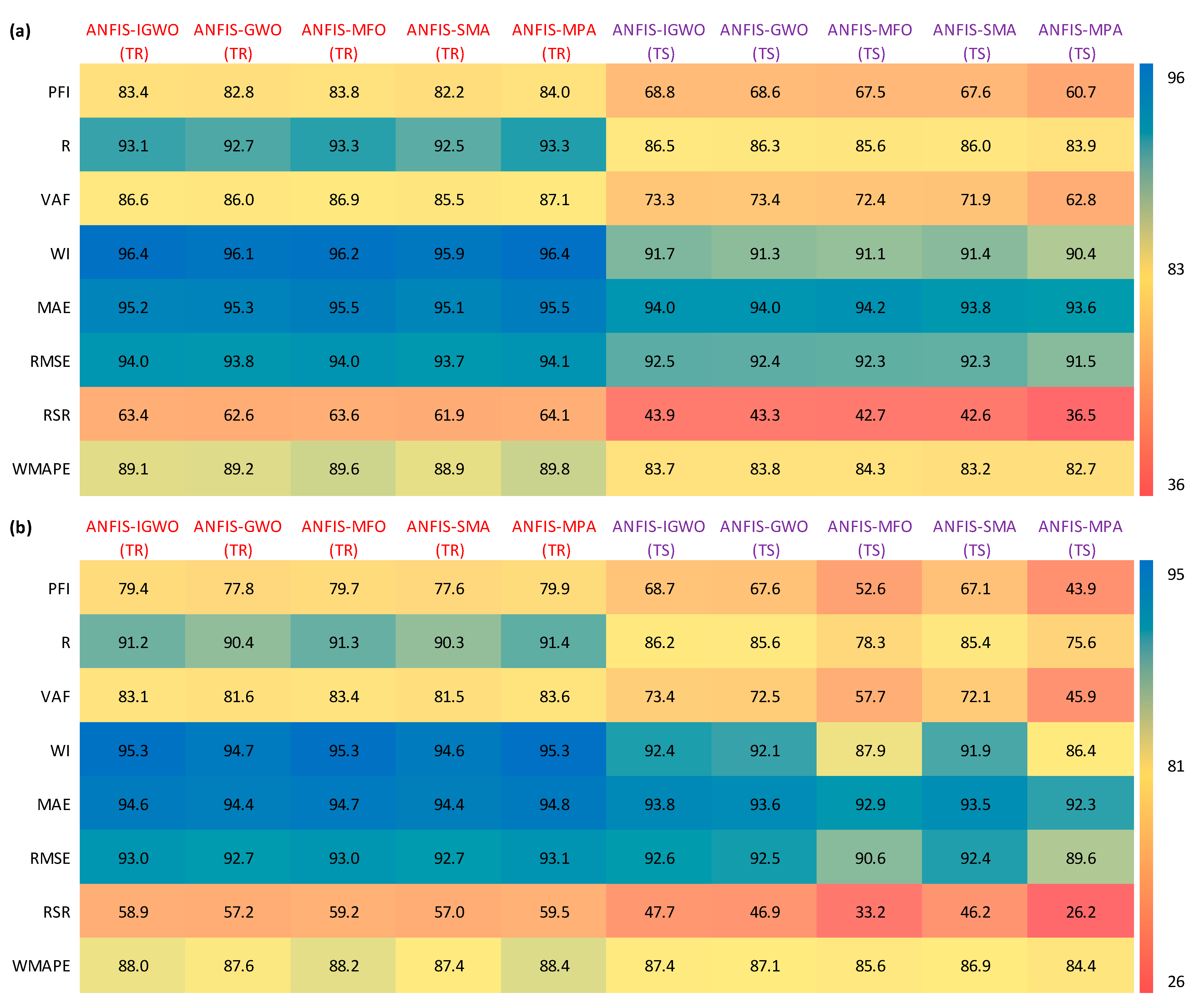
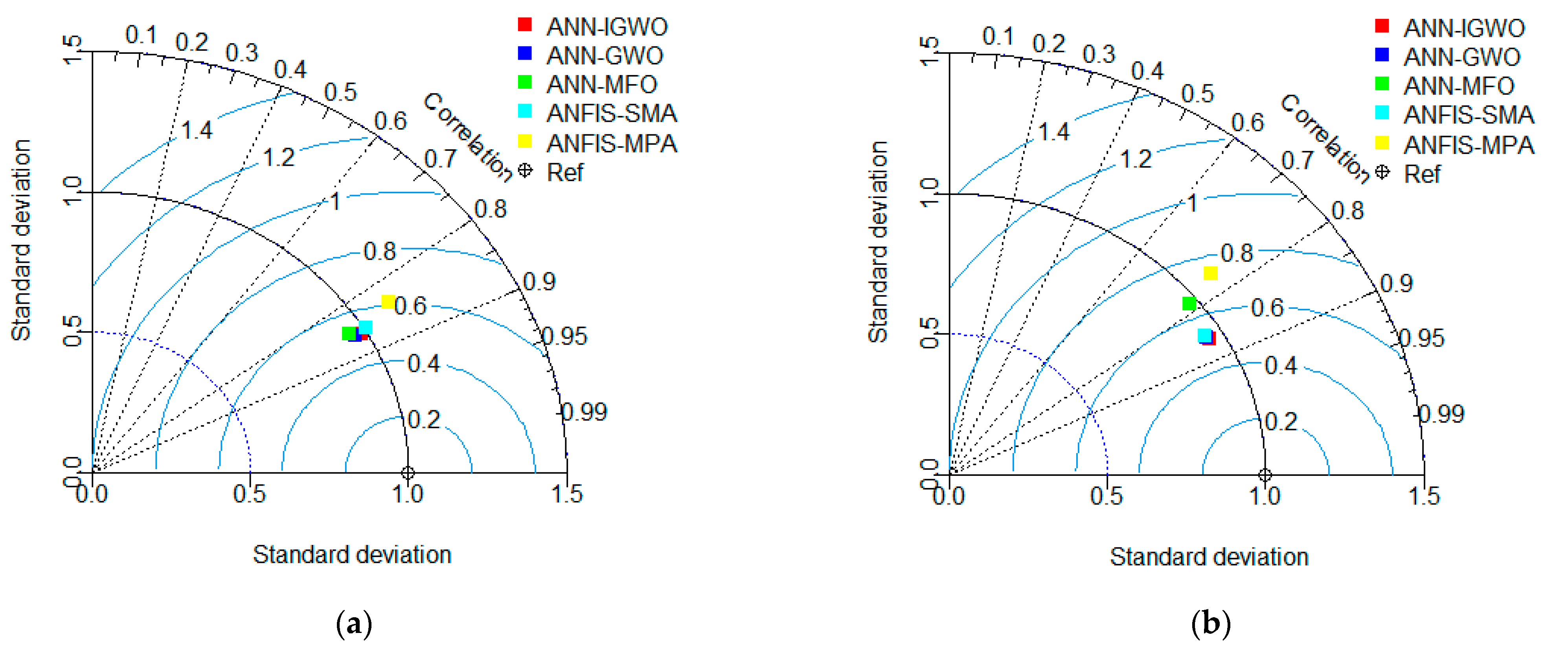
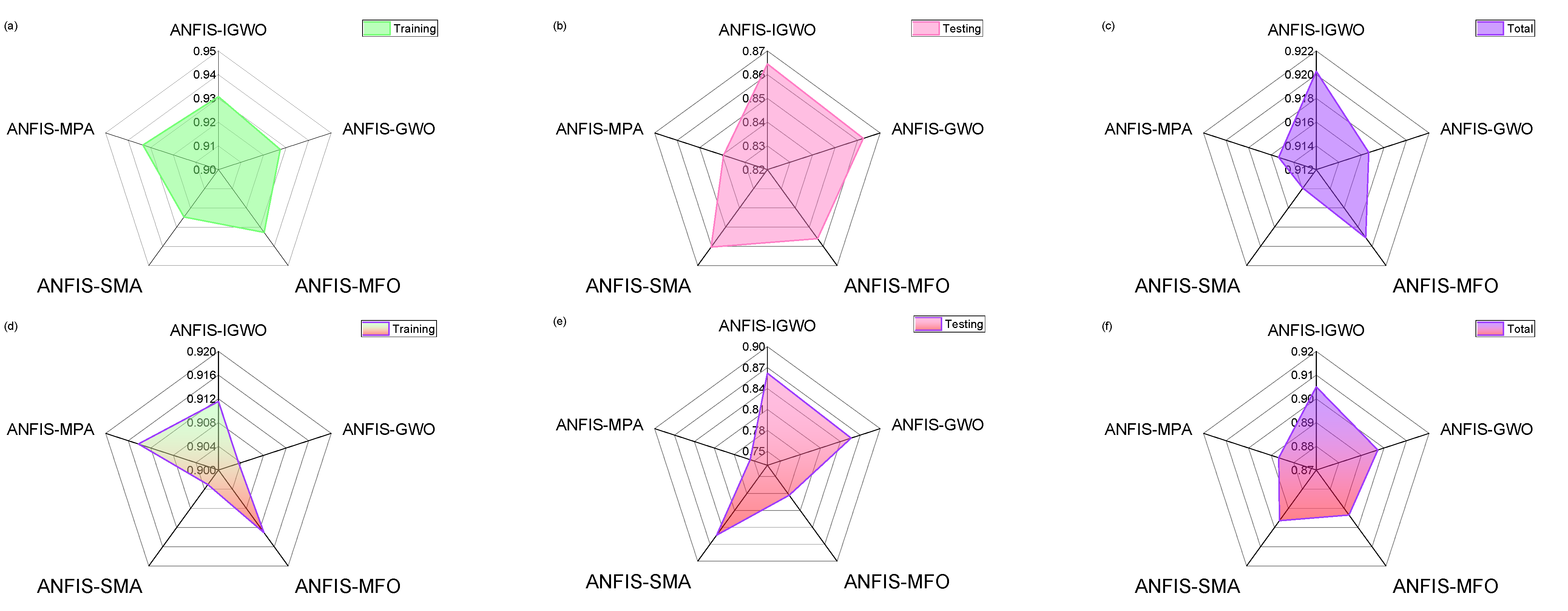
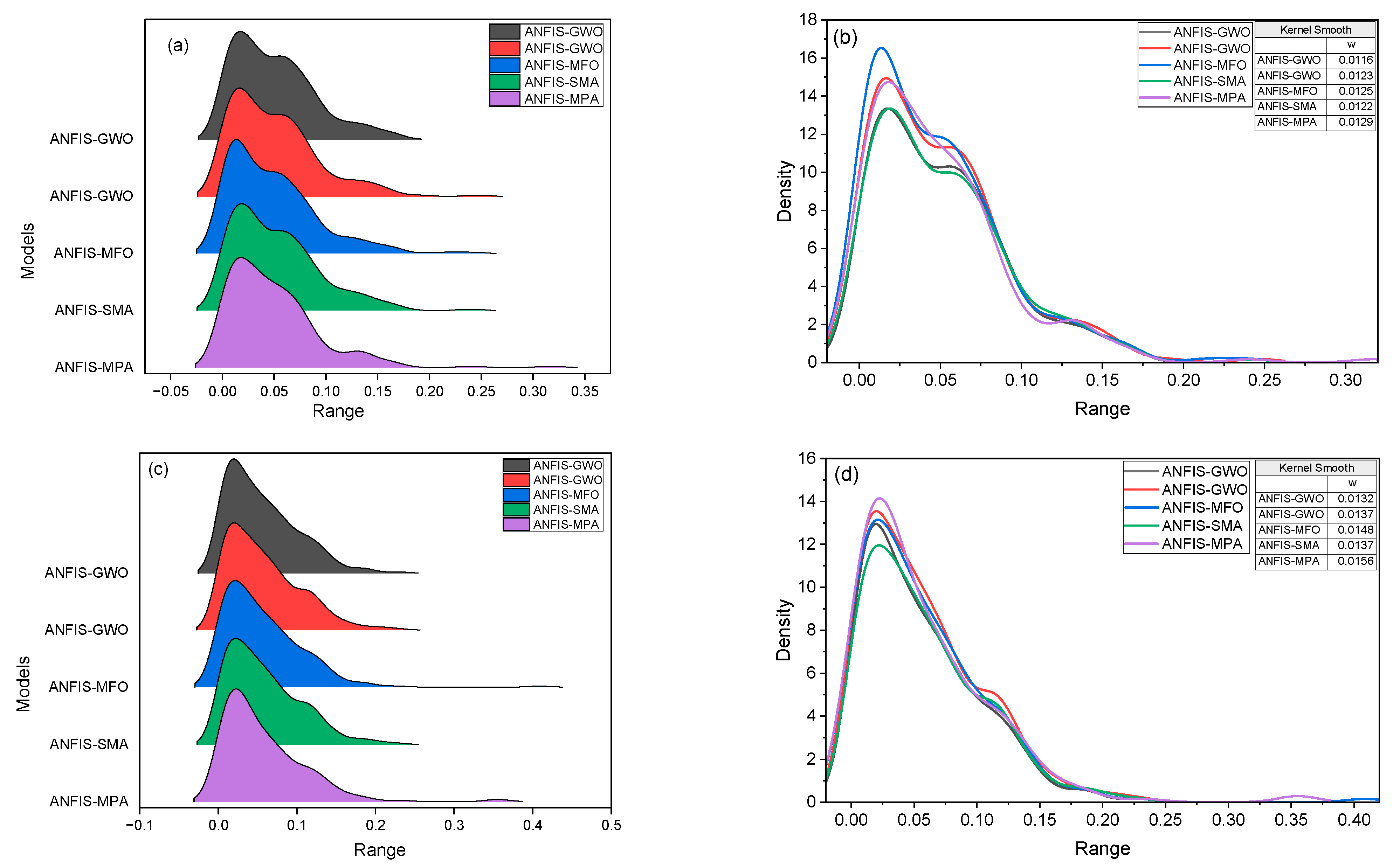
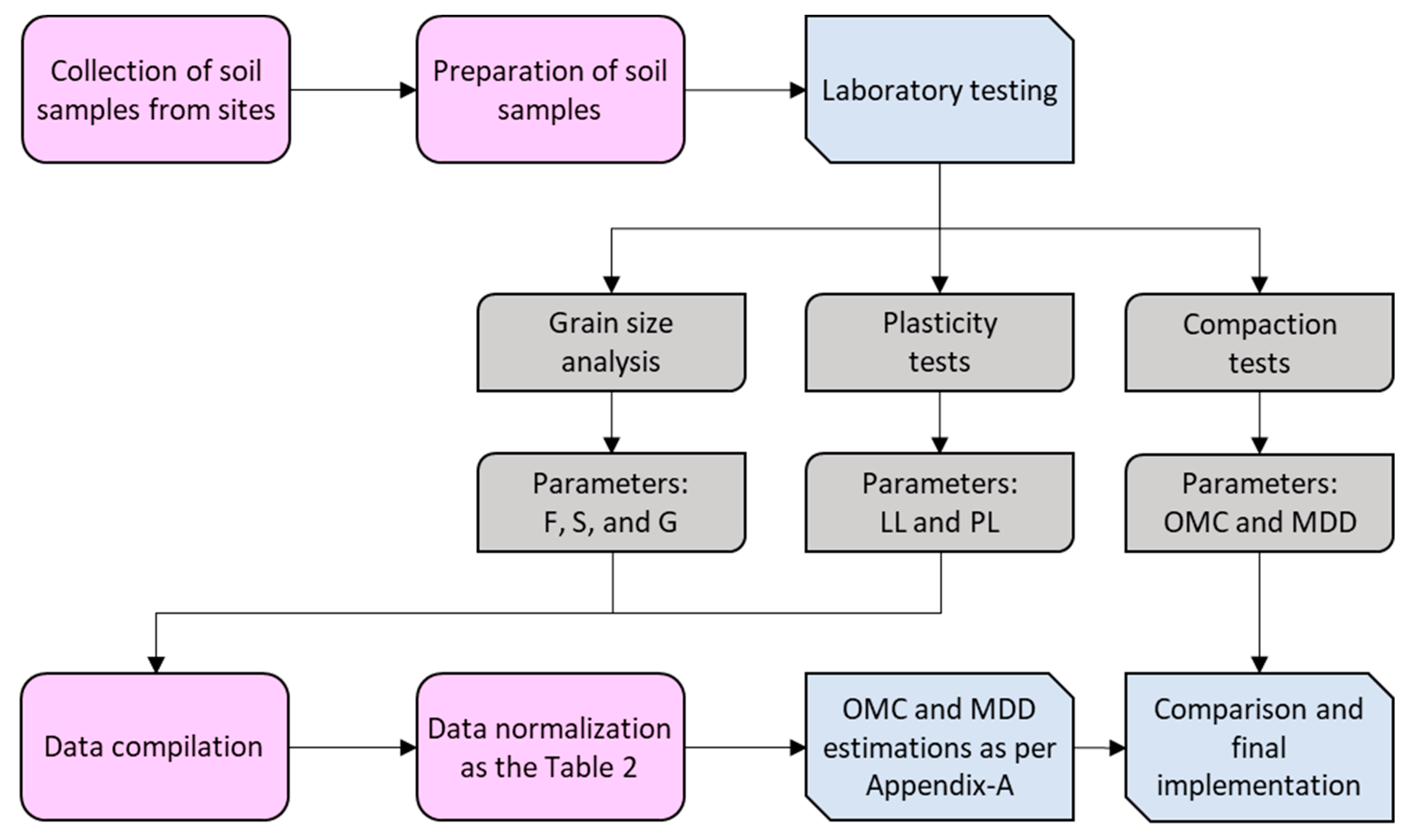
| Particulars | No. of Actual Data | Actual Data Dimension | No. of Data Selected | Final Data Dimension |
|---|---|---|---|---|
| Günaydın [15] | 126 | 126 × 8 | 126 | 126 × 7 |
| Wang and Yin [1] | 226 | 226 × 8 | 105 | 105 × 7 |
| Bardhan and Asteris [14] | 20 | 20 × 8 | 20 | 20 × 7 |
| Final dataset (for this study) | - | - | 251 | 251 × 7 |
| Particulars | F (%) | S (%) | G (%) | LL (%) | PL (%) | OMC (%) | MDD (kN/m3) |
|---|---|---|---|---|---|---|---|
| Min. | 8.60 | 0.00 | 0.00 | 16.00 | 6.10 | 7.00 | 13.73 |
| Avg. | 63.76 | 27.95 | 8.29 | 40.14 | 20.63 | 17.16 | 17.25 |
| Max. | 100.00 | 83.60 | 67.10 | 70.00 | 32.50 | 31.00 | 21.48 |
| Stnd. Error | 1.49 | 1.09 | 0.74 | 0.63 | 0.28 | 0.24 | 0.08 |
| Stnd. Dev. | 23.62 | 17.19 | 11.78 | 9.93 | 4.50 | 3.87 | 1.29 |
| Variance | 557.68 | 295.50 | 138.65 | 98.62 | 20.21 | 15.00 | 1.67 |
| Kurtosis | −0.90 | −0.31 | 3.55 | 0.20 | 0.15 | 0.87 | 0.54 |
| Skewness | −0.20 | 0.33 | 1.85 | 0.67 | −0.06 | 0.38 | 0.02 |
| Soil Types | F | S | G | LL | PL | OMC | MDD | |||||||
|---|---|---|---|---|---|---|---|---|---|---|---|---|---|---|
| Min. | Max. | Min. | Max. | Min. | Max. | Min. | Max. | Min. | Max. | Min. | Max. | Min. | Max. | |
| CH | 53.80 | 100.00 | 0.00 | 41.16 | 0.00 | 20.00 | 50.00 | 70.00 | 18.00 | 31.00 | 17.50 | 30.80 | 13.93 | 17.42 |
| CI | 49.00 | 75.00 | 21.00 | 44.95 | 0.05 | 23.07 | 35.15 | 49.40 | 14.40 | 26.72 | 13.95 | 23.75 | 15.19 | 19.41 |
| CL | 33.00 | 99.00 | 1.00 | 65.00 | 0.00 | 22.00 | 23.00 | 49.30 | 6.10 | 27.00 | 11.00 | 22.00 | 15.89 | 19.28 |
| CL-ML | 81.00 | 81.00 | 19.00 | 19.00 | 0.00 | 0.00 | 27.00 | 27.00 | 21.00 | 21.00 | 17.00 | 17.00 | 17.46 | 17.46 |
| GC | 13.00 | 41.50 | 19.90 | 45.61 | 30.39 | 67.10 | 27.60 | 63.20 | 13.40 | 26.11 | 7.60 | 18.80 | 16.43 | 20.51 |
| GM | 40.00 | 50.00 | 17.25 | 28.69 | 24.69 | 37.75 | 40.20 | 50.90 | 26.00 | 26.61 | 13.85 | 20.40 | 16.36 | 17.55 |
| GP-GC | 9.40 | 9.40 | 41.90 | 41.90 | 48.70 | 48.70 | 37.80 | 37.80 | 14.70 | 14.70 | 8.40 | 8.40 | 20.60 | 20.60 |
| GW-GC | 8.60 | 8.60 | 44.30 | 44.30 | 47.10 | 47.10 | 29.50 | 29.50 | 14.10 | 14.10 | 7.00 | 7.00 | 21.48 | 21.48 |
| MH | 60.00 | 100.00 | 0.00 | 36.48 | 0.00 | 3.52 | 50.40 | 64.00 | 26.00 | 32.50 | 19.40 | 31.00 | 13.73 | 16.09 |
| MI | 59.00 | 74.00 | 24.24 | 34.61 | 1.76 | 6.39 | 47.90 | 49.35 | 28.41 | 28.85 | 18.00 | 21.95 | 16.36 | 16.39 |
| ML | 53.00 | 90.00 | 10.00 | 37.00 | 0.00 | 10.00 | 25.00 | 47.00 | 14.55 | 28.00 | 10.40 | 22.00 | 15.89 | 19.24 |
| SC | 15.00 | 48.00 | 30.90 | 71.26 | 0.00 | 39.00 | 16.00 | 61.10 | 9.00 | 26.24 | 9.00 | 18.50 | 16.28 | 20.50 |
| SM | 44.00 | 44.00 | 56.00 | 56.00 | 0.00 | 0.00 | 16.00 | 16.00 | 9.00 | 9.00 | 9.00 | 9.00 | 20.01 | 20.01 |
| SP-SC | 8.80 | 8.80 | 83.60 | 83.60 | 7.60 | 7.60 | 31.20 | 31.20 | 19.30 | 19.30 | 10.80 | 10.80 | 19.13 | 19.13 |
| SW-SC | 9.60 | 9.60 | 77.30 | 77.30 | 13.10 | 13.10 | 30.40 | 30.40 | 18.80 | 18.80 | 9.80 | 9.80 | 19.72 | 19.72 |
| Phases | Models | PFI | R | VAF | WI | MAE | RMSE | RSR | WMAPE |
|---|---|---|---|---|---|---|---|---|---|
| Training | ANFIS-IGWO | 1.6686 | 0.9307 | 86.5973 | 0.9636 | 0.0479 | 0.0602 | 0.3662 | 0.1088 |
| ANFIS-GWO | 1.6550 | 0.9274 | 86.0065 | 0.9610 | 0.0473 | 0.0615 | 0.3741 | 0.1081 | |
| ANFIS-MFO | 1.6757 | 0.9328 | 86.8809 | 0.9622 | 0.0453 | 0.0598 | 0.3636 | 0.1036 | |
| ANFIS-SMA | 1.6439 | 0.9247 | 85.5093 | 0.9594 | 0.0487 | 0.0626 | 0.3808 | 0.1106 | |
| ANFIS-MPA | 1.6801 | 0.9335 | 87.1078 | 0.9638 | 0.0449 | 0.0590 | 0.3591 | 0.1025 | |
| Testing | ANFIS-IGWO | 1.3766 | 0.8645 | 73.3267 | 0.9167 | 0.0604 | 0.0754 | 0.5607 | 0.1627 |
| ANFIS-GWO | 1.3726 | 0.8625 | 73.3937 | 0.9132 | 0.0602 | 0.0762 | 0.5666 | 0.1623 | |
| ANFIS-MFO | 1.3494 | 0.8560 | 72.4010 | 0.9107 | 0.0584 | 0.0770 | 0.5729 | 0.1573 | |
| ANFIS-SMA | 1.3526 | 0.8604 | 71.9109 | 0.9143 | 0.0625 | 0.0772 | 0.5742 | 0.1683 | |
| ANFIS-MPA | 1.2137 | 0.8395 | 62.7992 | 0.9041 | 0.0641 | 0.0854 | 0.6353 | 0.1726 | |
| Total | ANFIS-IGWO | 1.6265 | 0.9203 | 84.6266 | 0.9577 | 0.0504 | 0.0635 | 0.3932 | 0.1182 |
| ANFIS-GWO | 1.6125 | 0.9167 | 84.0233 | 0.9549 | 0.0499 | 0.0647 | 0.4004 | 0.1176 | |
| ANFIS-MFO | 1.6222 | 0.9191 | 84.4224 | 0.9555 | 0.0479 | 0.0636 | 0.3936 | 0.1130 | |
| ANFIS-SMA | 1.6012 | 0.9139 | 83.5102 | 0.9536 | 0.0515 | 0.0658 | 0.4071 | 0.1207 | |
| ANFIS-MPA | 1.6066 | 0.9153 | 83.7206 | 0.9551 | 0.0488 | 0.0652 | 0.4032 | 0.1147 |
| Phases | Models | PFI | R | VAF | WI | MAE | RMSE | RSR | WMAPE |
|---|---|---|---|---|---|---|---|---|---|
| Training | ANFIS-IGWO | 1.5872 | 0.9116 | 83.0798 | 0.9526 | 0.0540 | 0.0702 | 0.4114 | 0.1202 |
| ANFIS-GWO | 1.5551 | 0.9036 | 81.6465 | 0.9471 | 0.0559 | 0.0731 | 0.4284 | 0.1243 | |
| ANFIS-MFO | 1.5933 | 0.9131 | 83.3592 | 0.9532 | 0.0529 | 0.0697 | 0.4085 | 0.1178 | |
| ANFIS-SMA | 1.5528 | 0.9030 | 81.5383 | 0.9464 | 0.0564 | 0.0734 | 0.4300 | 0.1256 | |
| ANFIS-MPA | 1.5981 | 0.9142 | 83.5737 | 0.9535 | 0.0522 | 0.0692 | 0.4053 | 0.1160 | |
| Testing | ANFIS-IGWO | 1.3740 | 0.8619 | 73.4131 | 0.9244 | 0.0620 | 0.0738 | 0.5229 | 0.1257 |
| ANFIS-GWO | 1.3524 | 0.8562 | 72.4607 | 0.9213 | 0.0636 | 0.0749 | 0.5308 | 0.1291 | |
| ANFIS-MFO | 1.0522 | 0.7831 | 57.7198 | 0.8794 | 0.0709 | 0.0943 | 0.6679 | 0.1438 | |
| ANFIS-SMA | 1.3428 | 0.8538 | 72.0656 | 0.9189 | 0.0646 | 0.0759 | 0.5381 | 0.1311 | |
| ANFIS-MPA | 0.8772 | 0.7560 | 45.8550 | 0.8642 | 0.0771 | 0.1042 | 0.7382 | 0.1564 | |
| Total | ANFIS-IGWO | 1.5630 | 0.9050 | 81.8582 | 0.9493 | 0.0556 | 0.0709 | 0.4256 | 0.1214 |
| ANFIS-GWO | 1.5328 | 0.8973 | 80.5090 | 0.9442 | 0.0574 | 0.0735 | 0.4407 | 0.1254 | |
| ANFIS-MFO | 1.5161 | 0.8935 | 79.7219 | 0.9429 | 0.0565 | 0.0752 | 0.4514 | 0.1234 | |
| ANFIS-SMA | 1.5292 | 0.8964 | 80.3568 | 0.9431 | 0.0580 | 0.0739 | 0.4433 | 0.1268 | |
| ANFIS-MPA | 1.4878 | 0.8866 | 78.3472 | 0.9401 | 0.0571 | 0.0774 | 0.4644 | 0.1247 |
Disclaimer/Publisher’s Note: The statements, opinions and data contained in all publications are solely those of the individual author(s) and contributor(s) and not of MDPI and/or the editor(s). MDPI and/or the editor(s) disclaim responsibility for any injury to people or property resulting from any ideas, methods, instructions or products referred to in the content. |
© 2023 by the authors. Licensee MDPI, Basel, Switzerland. This article is an open access article distributed under the terms and conditions of the Creative Commons Attribution (CC BY) license (https://creativecommons.org/licenses/by/4.0/).
Share and Cite
Bardhan, A.; Singh, R.K.; Ghani, S.; Konstantakatos, G.; Asteris, P.G. Modelling Soil Compaction Parameters Using an Enhanced Hybrid Intelligence Paradigm of ANFIS and Improved Grey Wolf Optimiser. Mathematics 2023, 11, 3064. https://doi.org/10.3390/math11143064
Bardhan A, Singh RK, Ghani S, Konstantakatos G, Asteris PG. Modelling Soil Compaction Parameters Using an Enhanced Hybrid Intelligence Paradigm of ANFIS and Improved Grey Wolf Optimiser. Mathematics. 2023; 11(14):3064. https://doi.org/10.3390/math11143064
Chicago/Turabian StyleBardhan, Abidhan, Raushan Kumar Singh, Sufyan Ghani, Gerasimos Konstantakatos, and Panagiotis G. Asteris. 2023. "Modelling Soil Compaction Parameters Using an Enhanced Hybrid Intelligence Paradigm of ANFIS and Improved Grey Wolf Optimiser" Mathematics 11, no. 14: 3064. https://doi.org/10.3390/math11143064
APA StyleBardhan, A., Singh, R. K., Ghani, S., Konstantakatos, G., & Asteris, P. G. (2023). Modelling Soil Compaction Parameters Using an Enhanced Hybrid Intelligence Paradigm of ANFIS and Improved Grey Wolf Optimiser. Mathematics, 11(14), 3064. https://doi.org/10.3390/math11143064







